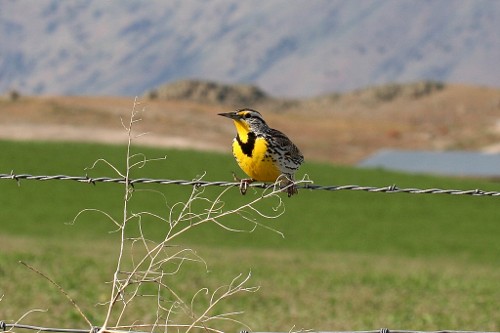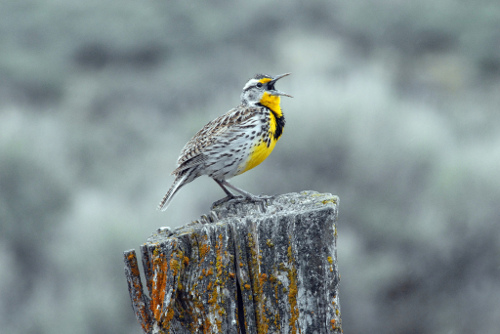
Fine, clear, dazzling, morning, the sun an hour high, the air just tart enough.
What a stamp in advance my day receives from the song of that meadow lark perch’d on a fence-stake twenty rods distant! Two or three liquid-simple notes, repeated at intervals, full of careless happiness and hope. With its peculiar shimmering slow progress and rapid-noiseless action of the wings, it flies on a way, lights on another stake, and so on to another, shimmering and singing many minutes.
Walt Whitman – Specimen Days, March 16, 1878
Distinctly a bird of the Americas, the First People often included this singing, long-legged, walking bird in many of their stories and legends, but it wasn’t until Lewis and Clark first noted the yellow-breasted bird in 1805 that it caught the attention of the ornithologists of their day.
Even so, it wasn’t until 1840 that this Western songbird was named. John James Audubon dubbed it neglecta (nee-GLEK-tah; Latin for neglected) because, as he wrote in 1840, although "the existence of this species was known to the celebrated explorers of the West, Lewis and Clark, no one has since taken the least notice of it."
Today the Western Meadowlark, Sturnella neglecta, is an abundant and familiar bird of open country that you can see singing its familiar song from fence posts along roadsides; or you might catch it walking though grasslands and agricultural areas with a few dozen others.
This bird is so well-loved that it is the official state bird for six Western states – Kansas, Montana, Nebraska, North Dakota, Oregon and Wyoming – and there is barely a western movie made that doesn’t have the familiar melodic song of the meadowlark in its soundtrack.
A member of the same bird family as blackbirds and orioles, the meadowlark is distinctly not a “black bird,” having a bright yellow breast and undercarriage, a bold black “V” on its chest, and a back of streaked brown and white (we’ll be forgiven if we think the bird looks like it is sporting a modern suit of clothes).
Meadowlark legs are long, and their tails are short, with white outer tail-feathers that are obvious in flight. During the breeding season the yellow and black become more pronounced.
In winter you can see meadowlarks in groups, or with other blackbirds and starlings. In early spring, they will be doing their dance of mating.
The male will begin singing continuously, a beautiful song advertising his presence to the females from shrub tops, fence posts, utility poles or any other high structure. If she notices him and there are no other male meadowlarks around to challenge him a sort of chase will begin, the pace kept by the female.
The male at some point will stop and face the female, breast forward, head up, and if she chooses to pay further attention to him they will mate and the female will then begin making a nest. Successful males will often mate with two (or more) females.
The female will build her nest on the ground, typically under dense vegetation which makes it very difficult to find. The nest will be built mostly from grass that is tightly interwoven, and it will be shaped like a dome, with side entrances. The completed nest will be very waterproof.
She will then lay four to six eggs and incubate them for 13 to 14 days. After the eggs hatch the female will provide most of the food, although the male may help a bit. The young meadowlarks will leave the nest 10 to 12 days after hatching. At this age they still cannot fly but can run very well, and, with the help of shadowy and cryptic feathers, can hide successfully in the grass.

Meadowlarks forage mostly on the ground, probing the soil with their bills, eating grasshoppers, beetles and caterpillars (even the hairy ones) by the thousands. In the fall and winter, seeds and grains become an important addition to their diet.
You will notice as you watch them on the ground that they neither hop nor run but always walk, a style of movement that is comparatively uncommon among birds. You may also notice that immediately upon landing the male will flirt his tale vigorously once or twice, showing the white outer feathers.
Western Meadowlarks are full-time residents throughout much of their range, but when deep snow covers food sources they may move into sheltered valleys. Some populations do appear to be long-distance migrants.
Here in Northern California, as in other parts of their range, Western Meadowlarks are abundant and widespread, but breeding populations have declined somewhat in recent years. Much of this decline can probably be attributed to habitat destruction from livestock grazing, mowing and development, and perhaps as a result of contamination from pesticides.
These birds are extremely sensitive to human disturbance during the breeding season and will abort nesting attempts if they are flushed while incubating eggs.
The meadowlark has a just claim on the affections of people whose fields he adorns.
Debra Chase is the executive director of Tuleyome. She resides on a small family farm in Colusa County.
Tuleyome is a local nonprofit working to protect both our wild heritage and our agricultural heritage for future generations. Past Tuleyome Tales articles are available in the library section of their Web site, www.tuleyome.org.